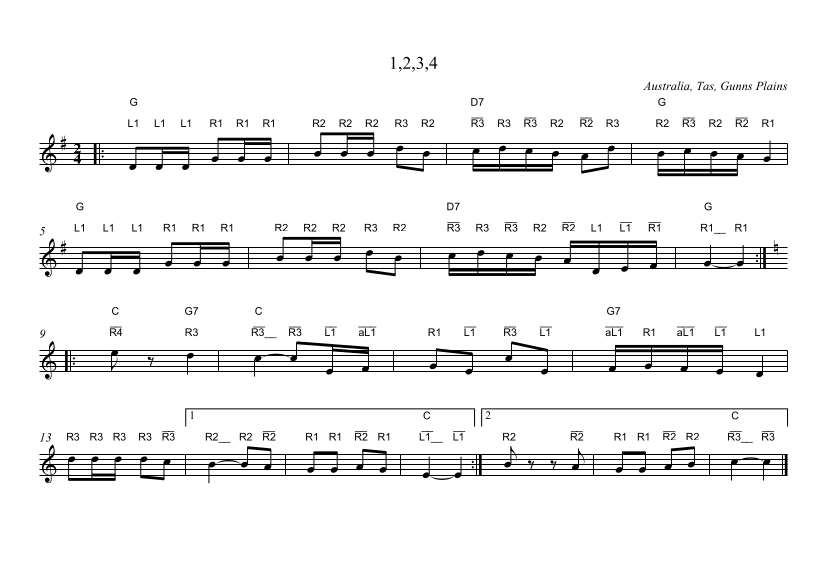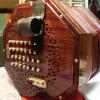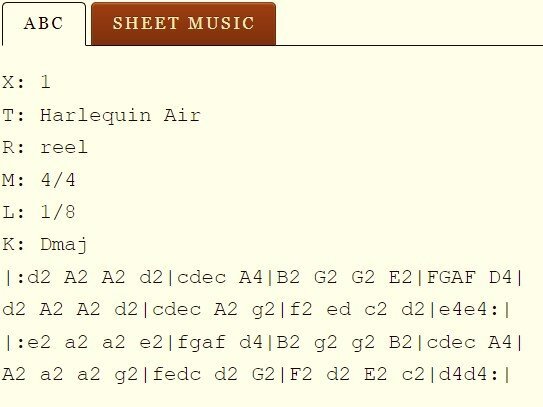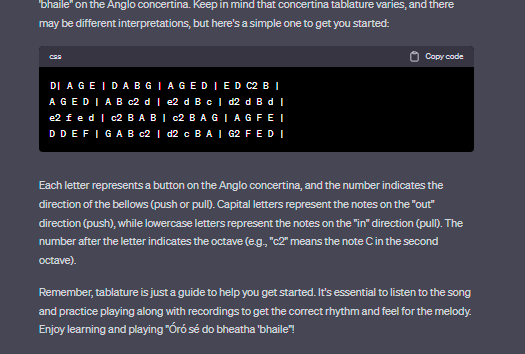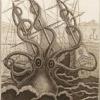Search the Community
Showing results for tags 'tablature'.
-
In this old thread there was some discussion (a side-bar to the main topic) about what mechanism to use to insert tablature (tabs, note-names, ABC-names) to a score. At the time I said that my preferred option was to use text annotations to do this. Fairly soon after this, I changed my mind, and started using lyrics (w:) lines as the vehicle for carrying the tablature, and have done so for some time now. I also wondered if symbol (s:) lines were a viable third option but didn't do anything about it. As a result of recent discussions, I finally got my act together and tried this. It seems to work, although there are up-sides and down-sides to this. Here's an example of what it looks like (not very good quality, I'm afraid): This is the only practical presentation as far as I can see. The accompaniment chords and s: lines seem to be tied together, they both use the same font, and moving them below the staff results in the accompaniment chords and tabs becoming mis-aligned, so it's limited - It looks 'better than I thought it did at first', though Question: Has anyone else here tried using ABC symbol (s:) lines as a way of adding tablature to a score? How d'ye think it looks? Ta. (Moderators, please move to more appropriate forum if necessary - I couldn't decide...) ______________________________ At present, I haven't actually modified my program(s) to do this, but am using an edit 'macro' to convert a file using lyrics (w:) lines to a a file using symbol (s:) lines... 1,2,3,4.abc
-
Giving advice to a new player to the concertina is like asking for directions: Everyone knows the best way to get there but most everyone's directions are different. Look at the buttons. Don't look at the buttons. Place it on your right knee. Place it on your left knee. Hold it up. Elbows in. Thumb straps tight. Thumb straps loose. Learn by ear. Learn to read ABC or music notation. Yeah, it is a lot to take in. So I say if you are new to the concertina and want to play, start playing. Pick a tune out and see how your body places itself as you play. Always seek out help from different players for ideas and suggestions to see what works for you. Attend sessions. Watch. Listen. Learn. And take some organized lessons either in a group or privately. I teach the English system using musical notation. I know Anglo teachers who use ABC notation as well. For the most basic beginner I will often use a fingering placed below each note to assist. Below are fingering notation I made for the EC and ABC charts for an Anglo (from thesession.org) for the reel Harlequin Aire. Both assist the player with bellow direction and fingering. Practice and learning the tune will eventually displace the need to constantly refer to these charts. HARLIQUIN AIRE.pdf
- 2 replies
-
- 1
-

-
- abc notation
- ec fingering notation
-
(and 2 more)
Tagged with:
-
Back in 2014 (I think) Gary Coover produced a one page survey of 30-button tablatures. It was still available as a PDF via a link from within concertina.net fairly recently, but I now can't find it. I should have bookmarked it!🙁 Can anyone help please? I ask because I just 'invented' a couple of new button naming schemes, and I want to check if I am a genius or merely a plagiarist...😊 Thanks
-
-
A simple question (I hope). Some folks use 'below-the-staff' note names as an aid to learning staff notation. Is there a convention for notating accidentals? That is, are accidentals depicted as (say) #C and #F, as they would appear in the score, or as C# and F#? I did a simple implementation of this scheme a while ago for a whistle class, and the accidentals problem did not occur because of the limited scope of a whistle. I now wish to generalise the implementation to include all notes. Thanks.
-
Here are two popular tunes that I have arranged and tabbed. They are scored in the key of G; but the tab will serve on any standard 30 button Anglo concertina. Due to the limitations of my musical software (GuitarPro 6), I regret that I had to modify Gary Coover's excellent tablature method. The tab is adapted from Gary Coover "Easy Anglo 1-2-3". The button numbering is the same. Numbers marked with △ are on the pull. Unmarked are push. No more lines above. All numbers the treble stave are played with the RH unless marked 'L'. All buttons on the bass stave are played with the LH unless marked 'R'. Gary's vertically stacked button numbers are written horizontally in my version. Apologies for these changes. I'm not attempting to better anything that others have done. College Hornpipe.pdf Lads of Alnwick.pdf
-
- Lads Alnwick
- College Hornpipe
-
(and 2 more)
Tagged with:
-
"The great thing about standards is that there are so many to choose from" - Andrew Tanenbaum Since the very first concertina tutor (Hoselbarth, c.1840), there have been over 130 tutors published for the Anglo, many with widely differing button numbering and tablature systems. The result of numerous attempts to try to make sense of the Anglo having two notes in different directions for each button, plus having alternate notes on other buttons. Standard musical notation by itself does not indicate which alternate note or direction is preferable, and since many published tutors print the music an octave high or low, learning actual notes still might not help much, hence the various attempts at tablature systems. Tablature patterns are easily transferable between instruments with different keys, so that's a good thing. Beginners often buy one or more tutors, only to be faced with having to sort out wildly dissimilar ways of counting buttons and indicating bellows direction. So.......here, in all its insanity, is a first draft of a notation "Rosetta Stone" translation chart for the 30-button Anglo showing about 30 of the different notating systems. Additions, corrections? What an embarrassing gawdawful mess! I know many systems have their adherents and staunch defenders, but could we make it any harder to learn this somewhat intuitive instrument? Pity the poor beginner! Gary 30-Button Notation Translator.pdf

